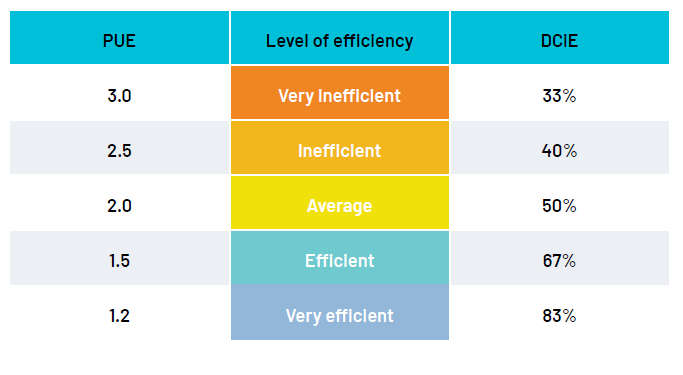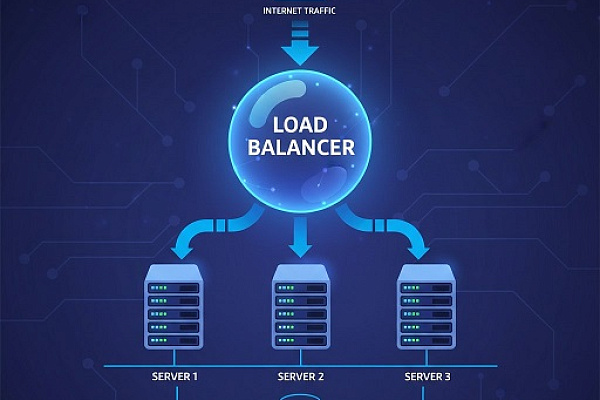Data centers now consume over 4% of the world's electricity, and in the United States, they account for roughly 9% of the nation's total usage. This massive demand translates into huge operational costs for businesses and a significantly larger carbon footprint for the planet. This is precisely why building energy-efficient data centers is more critical than ever.
To measure this efficiency, providers use a key metric: PUE, or Power Usage Effectiveness. This indicator reveals how rationally energy is being consumed.
What is a PUE? Definition and formula
PUE (Power Usage Effectiveness) is the industry-standard coefficient for evaluating a data center's energy efficiency.
This metric illustrates what percentage of the total electricity is used for its primary purpose—powering IT equipment. A data center also requires energy for cooling, lighting, air conditioning, security systems, and more. PUE helps us understand this split in energy consumption.
In simple terms, PUE is the total amount of electricity consumed by the entire facility divided by the energy used solely by the IT equipment (servers, storage, network gear). The closer to 1.0, the better.
Here is the PUE formula:
PUE = Total Facility Energy Consumption / IT Equipment Energy Consumption
Example: If a data center draws 100 kW from the grid and its servers and network equipment use 50 kW, the PUE is 2.0. This means for every 50 kW of useful work, another 50 kW is spent on overhead—indicating relatively low efficiency.
Key reasons why PUE is important?
PUE is far more than a technical number for reports. It's a crucial parameter that directly impacts business, ecology, and a data center's potential for growth.
Cost
High electricity consumption drives up the cost of building and operating a data center. A higher PUE means greater expenses for overhead systems like cooling. By lowering their PUE, a provider can reduce operational costs and offer more competitive services, strengthening their market position.
Carbon footprint
A high PUE is detrimental to the environment. It places an excessive load on power plants, resulting in higher CO2 emissions. A low PUE signals a company's responsible and sustainable approach. Many clients now prioritize this when choosing a provider.
Scalability
Energy efficiency directly determines growth potential. A lower PUE means less power is wasted on overhead, freeing up capacity for more server racks within the same facility. This gives the provider a strategic advantage: a higher potential for scaling their business.
PUE measuring in data centers

In practice, a perfect PUE is unattainable. Many factors influence it, from cooling technology to the outside air temperature. Here is a breakdown of common value ranges:
1.0 - The Unattainable Ideal: A PUE of 1.0 would mean 100% of the power is used by IT equipment with zero overhead — impossible in the real world.
1.1 - 1.2 - Excellent: Characteristic of state-of-the-art, purpose-built facilities. These data centers employ advanced technologies like free cooling, highly efficient UPS systems, and sophisticated monitoring.
1.3 - 1.5 - Good: The typical range for most quality data centers built in the last 5-7 years, featuring smart infrastructure and effective management.
1.6 - 1.8 - Average: Often found in older facilities with inefficient cooling systems (like air-cooled chillers) or poor airflow management. This range usually indicates a need for modernization.
2.0 and Above - Poor: A PUE above 2 is a warning sign, suggesting serious flaws in design or operation, common in small server rooms using outdated methods.
PUE is a dynamic metric
The PUE coefficient is variable and depends on three key factors:
-
Time of Year: Cooling systems work harder in summer, causing PUE to rise. It typically improves in the winter.
-
Data Center Load: During periods of low IT equipment usage (e.g., at night), the share of infrastructure power becomes larger, temporarily worsening the PUE.
-
Outside Temperature: The PUE can fluctuate daily based on changes in temperature and humidity.
This is why the annual average PUE is the only meaningful metric for comparison. One-off measurements are not reliable.
How to improve PUE?
Reducing PUE is a complex task requiring modern technology and intelligent design. Leading data centers use these key methods:Increasing Operating Temperature: Modern servers can reliably operate at higher temperatures (up to 27°C or even 40°C for some hardware). Moving away from "arctic" cooling standards (18-20°C) to warmer, acceptable ranges (22-24°C) drastically reduces cooling costs.
Free Cooling: In cooler climates, outside air can be used for cooling, partially or fully replacing energy-intensive chillers and compressors.
Airflow Optimization: Implementing hot aisle/cold aisle containment prevents the mixing of hot and cold air. Sealing gaps, using blanking panels in server racks, and strategic equipment placement ensure cold air is delivered precisely where it's needed, dramatically improving cooling efficiency.
Upgrading to Energy-Efficient Equipment: Investing in modern, high-efficiency UPS systems, LED lighting with motion sensors, and variable speed drives for pumps and fans reduces parasitic load. These capital investments often have a quick payback period due to energy savings.
An innovative approach: containerized data center
A popular and highly efficient solution is the modular or containerized data center. These are essentially pre-fabricated modules packed into a standard shipping container, complete with server racks, power, and cooling systems.
Their main advantage is outstanding energy efficiency. Thanks to optimized cooling (like indirect free-cooling or even immersion cooling) and dense equipment packing, these facilities can achieve record-low PUE values in the range of 1.1 to 1.3.
For example, a company like Cloud4Y offers rental of such containerized data centers. The infrastructure is fully redundant and reliable. The key benefit: there's no need to construct a separate building. You order it, it's delivered, connected, and you're operational.
This is an ideal solution for edge computing deployments in remote locations or for temporary projects where building a permanent facility isn't feasible.
The limits of PUE
PUE is a powerful tool, but with some limitations:
-
It Doesn't Measure IT Efficiency: A PUE of 1.1 doesn't guarantee the servers themselves are efficient. A data center can have low overhead but still use outdated, power-hungry servers. PUE reflects infrastructure quality, not computational efficiency.
-
It's a High-Level Metric: For a complete picture of a data center's sustainability, other metrics are needed. For instance, CUE (Carbon Usage Effectiveness) measures carbon emissions, and WUE (Water Usage Effectiveness) evaluates water consumption for cooling.
-
It Can Be Measured Incorrectly: The PUE value depends on where and when it's measured. An unethical operator might take a measurement only during optimal conditions. Always rely on annual average PUE values from reputable providers.
Conclusion
For nearly 20 years, PUE has remained the benchmark for energy efficiency and prestige in the data center industry. It indicates how much effort a provider invests in optimization and reducing environmental harm.
The drive for a better PUE stimulates progress on multiple fronts: businesses strengthen their market position, the digital industry's carbon footprint shrinks, and engineers continuously perfect new technologies. The benefits of a low PUE are far greater than they first appear.
For the end consumer, it's important to consider this. A low PUE has become a recognized sign of a mature, responsible, and forward-thinking business.



